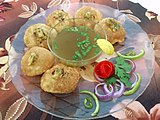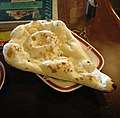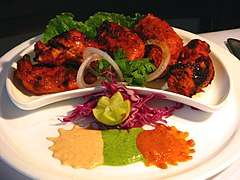Panipuri
Panipuri (![]()
![]()
 | |
| Alternative names | Paani patashi (Haryana) Pani ke batashe (Uttar Pradesh) Fulki (Madhya Pradesh) Golgappa, gol gappay or gol gappa (Delhi, Punjab) Phuchka (Bengal, Bihar, Jharkhand, Nepal) Phuska/Puska (Assam) Fuska (Sylhet and Chittagong) Gup-chup (Odisha, Chhattisgarh) Pakodi (Gujarat) |
|---|---|
| Type | Snack |
| Place of origin | Indian Sub-continent |
| Main ingredients | Flour, spiced water, onions, potatoes, chickpeas |
It consists of a round or ball-shaped, hollow puri (a deep-fried crisp crepe), filled with a mixture of flavored water (known as imli pani), tamarind chutney, chili, chaat masala, potato, onion or chickpeas.[2][3]
Names
Panipuri's name varies depending on the region. In Haryana it is known as paani patashi; in Madhya Pradesh fulki; in Uttar Pradesh pani ke batashe/padake ; in Assam phuska/puska; in parts of Gujarat, Gup-chup in parts of Odisha, Phuchka in Bengal, Bihar, Nepal, Jharkhand and Chhattisgarh.[4] It is popular by the name of Gol Gappe in some parts of Northern India (particularly Delhi).
Phuchka (or fuska or puska) differs from panipuri in content and taste. It uses a mixture of boiled yellow peas and spiced mashed potatoes as the filling,[4] and is tangy rather than sweetish while the water is sour and spicy. On 10 March 2005, "pani puri" was added to the Oxford English Dictionary.[5]
History
Pani Puri was reportedly first introduced in the ancient Kingdom of Magadha, which presides in the Southern part of Bihar. Introduced during the 600 BC, Pani Puris were called Phulki in the Kingdom of Magadha. According to a media report, during the ancient era, pani puris used to be much smaller, crispier than those of today.
However, there are other media reports suggests that pani puri was introduced by Draupadi, the wife of Pandavas, when she was challenged by her mother-in-law Kunti. Reportedly, one fine day Kunti threw a challenge at Draupadi, asking her to make a meal out of some leftover potato curry and a small amount of dough. Draupadi, who was married to the five Pandavas brothers, ideated a new recipe, made from the dough and potato curry, which later won her praise and appreciation from her mother-in-law Kunti, who also blessed the dish with immortality.[6]
Gallery
References
- Tarla Dalal, Chaat Cookbook., Gardners Books, 2000, 116 p. ISBN 978-81-86469-62-0
- Ramprasad, Gayathri (2014). Shadows in the Sun: Healing from Depression and Finding the Light Within. Hazelden. p. 260. ISBN 978-1-61649-531-2.
- Pani Puri recipe in Veg Recipes of India
- "11 Different Names For Your Favourite Pani Puri". indiatimes.com. Retrieved 12 June 2017.
- "March 2005 Update". Oxford English Dictionary.
- World, Republic. "Pani Puri & its connection to Five Pandavas & their wife Draupadi, know its history". Republic World. Retrieved 8 July 2020.
| Wikimedia Commons has media related to Panipuri. |








